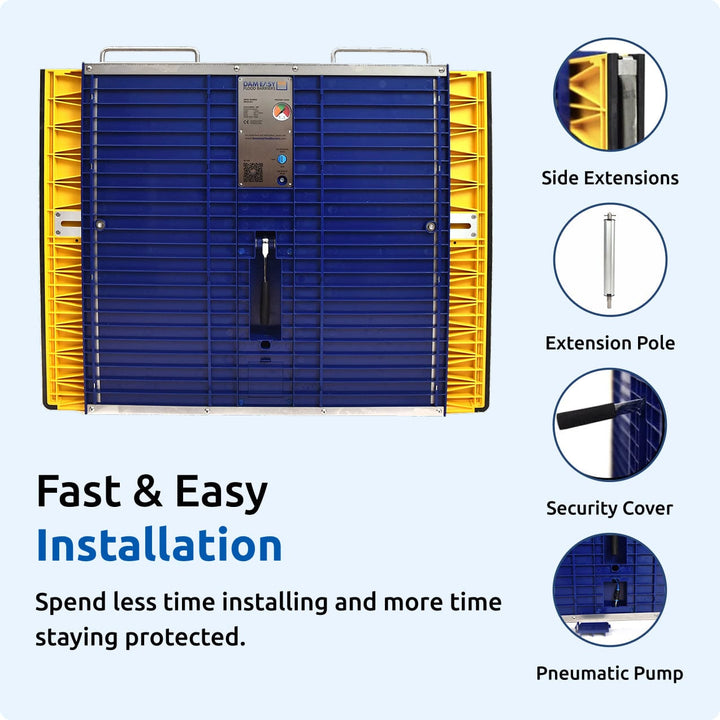After flood, cleaning may seem like a pretty hard quest. And dangerous also. Just imagine all that sand and dirt you will have to clear, especially if you used the good old sandbags instead of modern flood barriers. Moreover, floodwater could have been contaminated with sewers, chemicals, and other dangerous substances.
However, it is something you must do and get down to it as fast as possible. The longer floodwater and dirt will stay in your house; the worse will be the damage and following costs.
In this article, we shall talk about how to organize your after-flood cleaning and get the most out of the process, minimizing losses to the disaster.
Hold back and take a minute to evaluate the damage
Yes, we just said that the sooner you get down to after flood cleaning, the better, and you might already be eager to roll up your sleeves yourself. However, safety is first. Before grabbing that mop and going into a calf-deep floodwater puddle, it is essential to protect yourself and the people who may be around you during the cleaning process.
Let's talk about the 4 essential safety rules for after-flood cleaning:
- Gas and electricity - electric shock is the most common COD during the flood season, right after drowning. Gas poisoning, fires, and explosions caused by a damaged gas pipe come right after. Before grabbing that mop and entering the house, make sure that electricity and gas are shut off. Even then, it is best to wear rubber boots and gloves at all times and make sure that every room you are working in is well-aired;
- Building safety - Examine the building for visible cracks and structural damage before you enter. If you have the slightest doubt about the safety of the house itself, it is best to address a professional and stay away until you get an official approval;
- Safety gear - except for rubber boots and gloves that you should wear at all times while working in a flooded house, make sure to protect your eyes and respiratory system. Floodwater often becomes an incubator for disease and helps it spread;
- The first aid kit - arrange a small first aid kit that will help you deal with small cuts and scratches. Disinfect your hands and all surfaces that you may touch. Keep a working cellphone close at all times to be able to call for help if you get injured seriously. If you suddenly feel nauseous, get a headache or feel tired in the middle of cleaning, stop and leave the house immediately. It may be caused by gas leakage or the spread and mix of chemicals in the floodwater.
Cleaning is not enough.
Another essential thing to remember is that it probably won't be enough just to clean the surface affected by floodwater. To make sure that your house is safe to live in, you will have to disinfect all surfaces and items thoroughly.
Unless you used flood barriers for your home, there is a big chance that floodwater got into the house and soaked into floors and carpets, wallpaper and furniture. The worst thing about floodwater is that you never know where it was. Even worse, you know that the floodwater was everywhere, including local sewers, dumpsters, compost pits, and all the nastiest, dirtiest places you can think of in your neighborhood.
And now all that dirt, debris, and bacteria have settled in your house, on your walls, furniture, and floors. It can be invisible and reveal itself several weeks or even months after the flooding. But one day, you may notice that your carpet "smells funny," there is a weird stain on the kitchen floor, or your curtains that you have dried thoroughly are covered with tiny black dots.
All these are symptoms of the development of mold and signs that you after flood cleaning were... less than perfect.
That is why you should head to your local store and get big bottles of cleaning disinfectants to make sure that you won't just waste a load of time and effort on your after-flood cleaning.
Here are some tips on choosing the right cleaning products:
- Buy big packages. Not only does it comes out cheaper, but it is always best to be left with some product rather than start cutting corners on the cleaning process;
- Aerosol products might seem more convenient to use, but leave them for the happier times when your house is already clean. They are less efficient and more expensive than analogs that come in the form of powder or liquids;
- Choose products carefully. Whatever may work perfectly for your tile floor or bathroom may destroy wooden surfaces. Choose products for each type of material you will have to clean.
Next time is prepared.
It is always much easier and cheaper to prevent a disaster than deal with its outcomes. The less floodwater will manage to get on your property, the lower the risks and hazards and less cleaning you will have to do after the flood.
To prepare for the next flood season, get a set of flood barriers for your home, flood gates for the garage, and other modern anti-flooding solutions that seal every passage of your property and are easy to install and remove after the water retreats.

Contact Dam Easy today and learn more about flood barriers for homes and other modern anti-flooding solutions that will keep you and your house safe during the floods and minimize losses and risks after.
$1,260.00
DAM EASY® FLOOD GATE - DOOR DAM Floods are becoming more common around the world. What was once a 100-year phenomenon is now a seasonal trend that homeowners must deal with. That’s EXACTLY why you need this Dam Easy Flood… Read MoreFlood Barrier Door Dam - Ultimate Flood Gate





